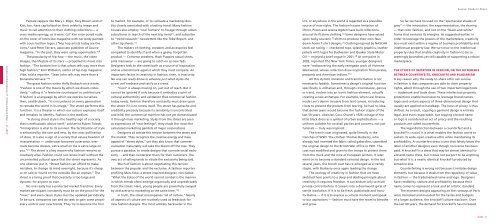Testimony of David Wolfe, Creative Director The ... - Public Knowledge
Testimony of David Wolfe, Creative Director The ... - Public Knowledge
Testimony of David Wolfe, Creative Director The ... - Public Knowledge
You also want an ePaper? Increase the reach of your titles
YUMPU automatically turns print PDFs into web optimized ePapers that Google loves.
E s s a y s : Ready t o S h a r e<br />
Female rappers like Mary J. Blige, Foxy Brown and Lil’<br />
to market, for example, or to cultivate a marketing iden-<br />
U.S. or anywhere in the world is regarded as a plausible<br />
So far we have focused on the “spectacular shades <strong>of</strong><br />
Kim, too, have capitalized on their celebrity image and<br />
tity closely associated with a lasting trend. Many fashion<br />
source <strong>of</strong> new styles. <strong>The</strong> fashion houses Imitation <strong>of</strong><br />
gray” — the innovation, the experimentation, the sharing<br />
music to call attention to their clothing collections — a<br />
houses also employ “cool hunters” to forage through urban<br />
Christ, Preen and Jessica Ogden have built collections<br />
— that color fashion, and not on the “black-and-white”<br />
cross-media synergy, as it were. (Lil’ Kim once posed nude<br />
subcultures in search <strong>of</strong> the next big trend 21 , and subscribe<br />
around thrift-store clothing. 24 Some designers have seized<br />
frame that contains its energies. As suggested earlier, in<br />
on the cover <strong>of</strong> Interview magazine with her body painted<br />
with Louis Vuitton logos.) “Hip hop artists today are the<br />
to “trend research” newsletters like the Tobé Report. and<br />
other tip sheets. 22<br />
upon tacky souvenir T-shirts to produce their own faux<br />
down-home T-shirt designs. 25 Clothing inspired by NASCAR<br />
order to leverage the powers <strong>of</strong> the marketplace, creativity<br />
also must exist within a regime <strong>of</strong> business pr<strong>of</strong>itability and<br />
icons,” said Peter Ferraro, associate publisher <strong>of</strong> Source<br />
magazine. “In the past, they were using supermodels.” 18<br />
<strong>The</strong> makers <strong>of</strong> clothing, sneakers and accessories feel<br />
compelled to identify if and when a geeky, forgotten<br />
stock-car racing — checkered tops, splashy graphics, leather<br />
jackets with logos for Budweiser and Quaker State Motor<br />
intellectual property law. We turn now to the intellectual<br />
property rules that enable creativity in fashion to be so<br />
<strong>The</strong> popularity <strong>of</strong> hip-hop — the music, the video<br />
product — Converse sneakers, Hush Puppies casual shoes,<br />
Oil — enjoyed a brief vogue in 2001. 26 At one point in<br />
seemingly boundless yet still capable <strong>of</strong> supporting a robust<br />
images, the lifestyle <strong>of</strong> its stars — propelled its move into<br />
pink menswear — are going to catch on as new fads.<br />
2002, reported <strong>The</strong> New York Times, younger designers<br />
marketplace.<br />
page 36 | Ready to Share: Fashion & the Ownership <strong>of</strong> Creativity<br />
fashion. “<strong>The</strong> bottom line is that urban sells way more than<br />
high fashion,” Emil Wilbekin, editor <strong>of</strong> hip-hop magazine<br />
Vibe, told a reporter. “Sean John sells way more than a<br />
Donatella Versace.” 19<br />
<strong>The</strong> great fashion writer Holly Brubach once wrote,<br />
“Fashion is one <strong>of</strong> the means by which we dream collectively,”<br />
calling it “a feminine counterpart to architecture.”<br />
If fashion is a language by which we express ourselves,<br />
then, said Brubach, “it is incumbent on every generation<br />
to remake the world in its image.” <strong>The</strong> street performs this<br />
function. It is a theater in which our culture expresses itself<br />
and remakes its identity. Fashion is the medium.<br />
“A strong street style is the healthy sign <strong>of</strong> a society<br />
that is enthusiastic about itself,” said artist Ruben Toledo.<br />
“Immigration is vital to its survival. <strong>The</strong> fertilization <strong>of</strong> style<br />
is enhanced by the rare and new, by the cross-pollination<br />
Designers look to the street both as a source <strong>of</strong> inspiration<br />
and as a benchmark against which they must compete. An<br />
important factor in creativity in fashion, then, is insecurity.<br />
No one can really know in advance just what styles the<br />
street will embrace and ratify as a trend.<br />
“Cool” is always moving on, just out <strong>of</strong> reach. But it<br />
cannot be ignored if only because it embodies a spirit <strong>of</strong><br />
cultural authenticity and validation that commercial fashion<br />
today needs. Fashion therefore constantly must draw upon<br />
the street if it is to renew itself. <strong>The</strong> street has panache and<br />
credibility precisely because its sensibility is uncontrolled<br />
and wild; the commercial machine has not yet domesticated<br />
it through mass marketing. Styles from the street are seen<br />
as expressions <strong>of</strong> “real feelings”; they elude (for now) the<br />
calculated marketing gambits <strong>of</strong> major corporations.<br />
Designers sit astride this tension between the street and<br />
were “rediscovering the early renegade work <strong>of</strong> Vivienne<br />
Westwood, whose collection drew inspiration from pirates,<br />
peasants and American Indians.” 27<br />
All this stylistic imitation and transformation is not<br />
necessarily faddish. Sometimes a design’s original function<br />
specifically is utilitarian and, through circumstance, genius<br />
or trend, evolves into an iconic fashion element, actually<br />
creating a new archetype. For example, when Levi Strauss<br />
made Levi’s denim trousers from tent canvas, introducing<br />
rivets to prevent the pockets from tearing, he had no idea<br />
that denim jeans would become the fashion staple <strong>of</strong> the<br />
last 50 years. Likewise, Coco Chanel’s 1926 coinage <strong>of</strong> the<br />
little black dress as a symbol <strong>of</strong> urban sophistication — a<br />
uniform suitable for cocktail parties and concerts, not just<br />
funerals — truly was inspired.<br />
<strong>The</strong> trench coat originated, quite literally in the<br />
the ethics <strong>of</strong> imitation in fashion, or the difference<br />
between counterfeits, knock<strong>of</strong>fs and plagiarism<br />
A key reason why the ready-to-share ethic can survive<br />
in fashion is that companies are able to claim property<br />
rights, albeit through the use <strong>of</strong> two important legal tools<br />
— trademark and trade dress. <strong>The</strong>se intellectual property<br />
protections enable businesses to leverage brand names,<br />
logos and certain aspects <strong>of</strong> three-dimensional design that<br />
usually are applied to handbags. <strong>The</strong> locus <strong>of</strong> piracy is thus<br />
shifted. As a result, copying a garment design is entirely<br />
legal, and even respectable, but copying a brand name<br />
or logo is considered an act <strong>of</strong> piracy and the resulting<br />
products are called counterfeits.<br />
<strong>The</strong> legal distinction between a counterfeit and a<br />
knock<strong>of</strong>f is crucial. It is what enables the fashion world to<br />
<strong>of</strong> ideas. It is also a sign <strong>of</strong> a society that values freedom <strong>of</strong><br />
the market. <strong>The</strong>y recognize the creative energy and mass<br />
trenches <strong>of</strong> WWI. <strong>The</strong> clothier Thomas Burberry, who<br />
sustain its wide-open creative ethic while maintaining its<br />
interpretation — underwear becomes outerwear, over-<br />
appeal <strong>of</strong> “street styles,” yet they also know that commer-<br />
already had invented the fabric called gabardine, submitted<br />
pr<strong>of</strong>itability. A counterfeit dress is one that falsely bears the<br />
coats become dresses, extra small on me is extra large on<br />
cialization ineluctably will take the bloom <strong>of</strong>f the rose. <strong>The</strong>y<br />
the original design to the British War <strong>of</strong>fice in 1901. <strong>The</strong><br />
label <strong>of</strong> another designer even though no license has been<br />
you.” 20 <strong>The</strong> street is a key reason why fashion remains so<br />
pursue a paradox: to create designs that connote social exclu-<br />
coat was modified and given to the troops to protect them<br />
paid. A knock<strong>of</strong>f is a dress that may be almost identical to<br />
creatively alive. Fashion could not renew itself without the<br />
sivity … and then reinterpret them for their customers. <strong>The</strong><br />
from the muck and the mire <strong>of</strong> European winters. It later<br />
a brand-name dress, but it does not purport to be anything<br />
uncontrolled cultural space that the street represents. As<br />
very act <strong>of</strong> selling tends to vitiate the exclusivity being sold.<br />
went on to become a standard raincoat design. In the last<br />
but what it is: a nearly identical knock<strong>of</strong>f produced by<br />
one observer put it, “Street fashion can afford to make<br />
Much <strong>of</strong> fashion is about negotiating this tension<br />
several years, the trench coat has re-emerged as a trendy<br />
someone else.<br />
mistakes, to change its mind overnight, because it’s cheap<br />
between the popular and the exclusive. A fashion reporter<br />
staple, with Burberry once again leading the charge.<br />
Counterfeiting is wrong not because it imitates design<br />
or on sale or found on the curbside like an orphan.” <strong>The</strong><br />
pr<strong>of</strong>iling Marc Ecko, a street-inspired designer, concluded:<br />
<strong>The</strong> ecology <strong>of</strong> creativity in fashion that we have<br />
elements, but because it steals from the repository <strong>of</strong> value<br />
street is a living pro<strong>of</strong> that creativity is too large and<br />
“What the Eckos <strong>of</strong> the world cannot combat is the manner<br />
sketched here points to a deep and abiding principle about<br />
in fashion — the trademarked name and logo. Designers<br />
dynamic for anyone to own.<br />
in which trends <strong>of</strong>ten emerge organically and unpredictably<br />
creativity: It requires freedom. It can endure only so much<br />
have credibility, stature and pr<strong>of</strong>itability because their<br />
No one really has a protected market franchise. Every<br />
market participant constantly must be on the prowl for the<br />
from the street. Here, young people are powerfully swayed<br />
by and averse to marketing at the same time.” 23<br />
private control before it careens into a downward spiral <strong>of</strong><br />
sterile involution. If it is to be fresh, passionate and trans-<br />
name comes to represent a look and an artistic standard.<br />
<strong>The</strong> moment designs appearing on the runways <strong>of</strong> Paris<br />
“new,” and even classic styles must be updated periodically.<br />
In truth, the street encompasses “all <strong>of</strong> culture.” Nearly<br />
formative — if it is to express a cultural moment and speak<br />
were mimicked and mutated for the tastes and budgets<br />
To be sure, companies can and do seek to gain some propri-<br />
all aspects <strong>of</strong> culture are routinely used as feedstock for<br />
to our aspirations — fashion must have the room to breathe<br />
<strong>of</strong> a larger audience, the knock<strong>of</strong>f culture was born. Over<br />
etary control over new trends. <strong>The</strong>y try to become the first<br />
new fashion designs. <strong>The</strong> most unlikely backwater in the<br />
and grow.<br />
the last 60 years, the demand for knock<strong>of</strong>fs has increased<br />
page 37





